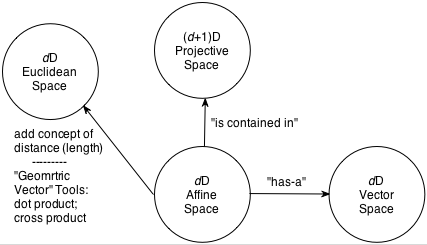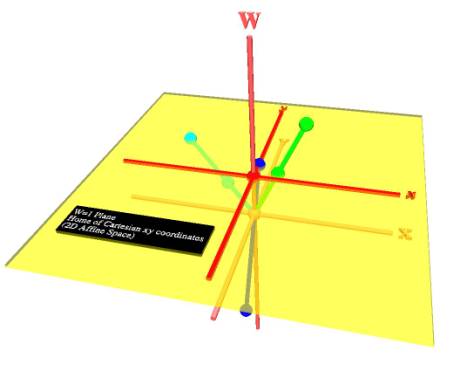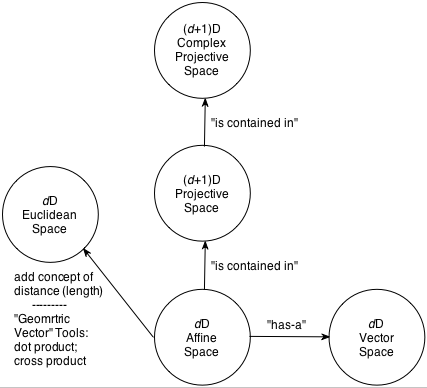Understanding Geometry:
The Abstract Spaces in Which Points and Vectors Live
Vector Spaces
Definition: A d-dimensional Vector Space consists of (i) a
set of vectors, and
(ii) two operations: addition and scalar multiplication.
The vector space is closed under these two operations.
There is a distinguished member of the set called the zero vector, 0, with the properties:
∀ real numbers, a: a·0 = 0
∀ vectors, v, in the vector space: 0 + v = v + 0 = v
Affine Spaces
Definition: A d-dimensional Affine Space consists of (i) a set of points,
(ii) an associated d-dimensional vector space, and (iii) two
operations: (iii.a) subtraction of two points in the set (which yields a vector in the
associated vector space), and (iii.b) addition of a point in the affine space to a vector in
the associated vector space (which yields another point in the affine space).
Unlike a vector space which has the distinguished element 0, there is no
distinguished point of an affine space.
Comments
- These two definitions define an abstract algebra
for abstract points and vectors.
Our interest will be in what we will call geometric points and vectors,
specifically points and vectors in 2D (d=2) and 3D (d=3) space.
- Since they are first and
foremost members of these two spaces, all of their formal properties – including
the set of valid operations we can perform on them –
derive from these two definitions. Note in particular that the definitions dictate
that you can only add and scale vectors, and that you can only subtract two points
and add a point and a vector. This seems extremely limited – you cannot scale
a point like you
can scale a vector, for example – but we will soon
discover a few higher level and very familiar operations that can be proven to
be valid and consistent with the restrictions embodied in the two definitions.
- Geometric points are characterized as a position in space. While
they are typically referenced via coordinates expressed in some reference
coordinate system, it is important to recognize that a point exists independent
of any coordinate system
- Geometric vectors are characterized as a direction and a
length. Vectors have no position.
- An additional property of interest related to geometric
points and vectors relates
to measuring lengths and will allow us to characterize such quantities as the
distance between points
(and hence the sizes of objects) and lengths of vectors. But notice that neither
the vector space definition nor the affine space definition includes any notion
of distance or size. We therefore need another formalism – another space.
Our geometric
points and vectors live
in a Euclidean Space as described next.
Euclidean Spaces
Definition: A d-dimensional Euclidean Space is a d-dimensional
Affine Space with the additional concept
of distance or length.
Two additional extremely important vector operations (whose definitions involve
lengths) can be defined for Euclidean Spaces:
- The dot product (also called the inner product)
of two vectors in the vector space:
The dot product produces a
scalar (i.e., a real number).
- The cross product: In 3D vector spaces, the
cross product of two vectors in the vector space produces
another vector in the vector space.
Projective Spaces


Definition: A (d+1)-dimensional projective space is a space
in which the points of a d-dimensional affine space are embedded.
We denote the extra coordinate dimension as w and say that the entire set of
d-dimensional
affine points lies in the w=1 plane of the projective space.
All projective space points on the line from the projective space origin
through an affine point on the w=1 plane are said to be projectively
equivalent to one another (and hence to the affine space point). In three-dimensional
affine space, for example, the affine space point R=(x,y,z) is projectively
equivalent to all points
RP=(wx, wy, wz, w) for w≠0.
Points in projective space will be of interest to us in two contexts:
- When computing the perspective projection of points
in a 3D scene, we will use a
matrix that generates 4D points that are the projective equivalents of the
affine points we seek.
- Rational curves and surfaces (e.g.,
rational Bezier and rational B-Splines) can be defined using points in projective
space whose projectively equivalent affine space points – called
"control points" – influence the shape of the curve or surface.
Complex Projective Spaces

Definition: A (d+1)-dimensional complex projective space is a
(d+1)-dimensional projective space in which the coordinates of points
are allowed to be complex numbers.
This most general of the spaces we will study is important in part because
many fundamental theorems of Geometric Modeling (e.g.,Bezout’s Theorem
related to curve and surface intersections) are proven
in complex projective space.


